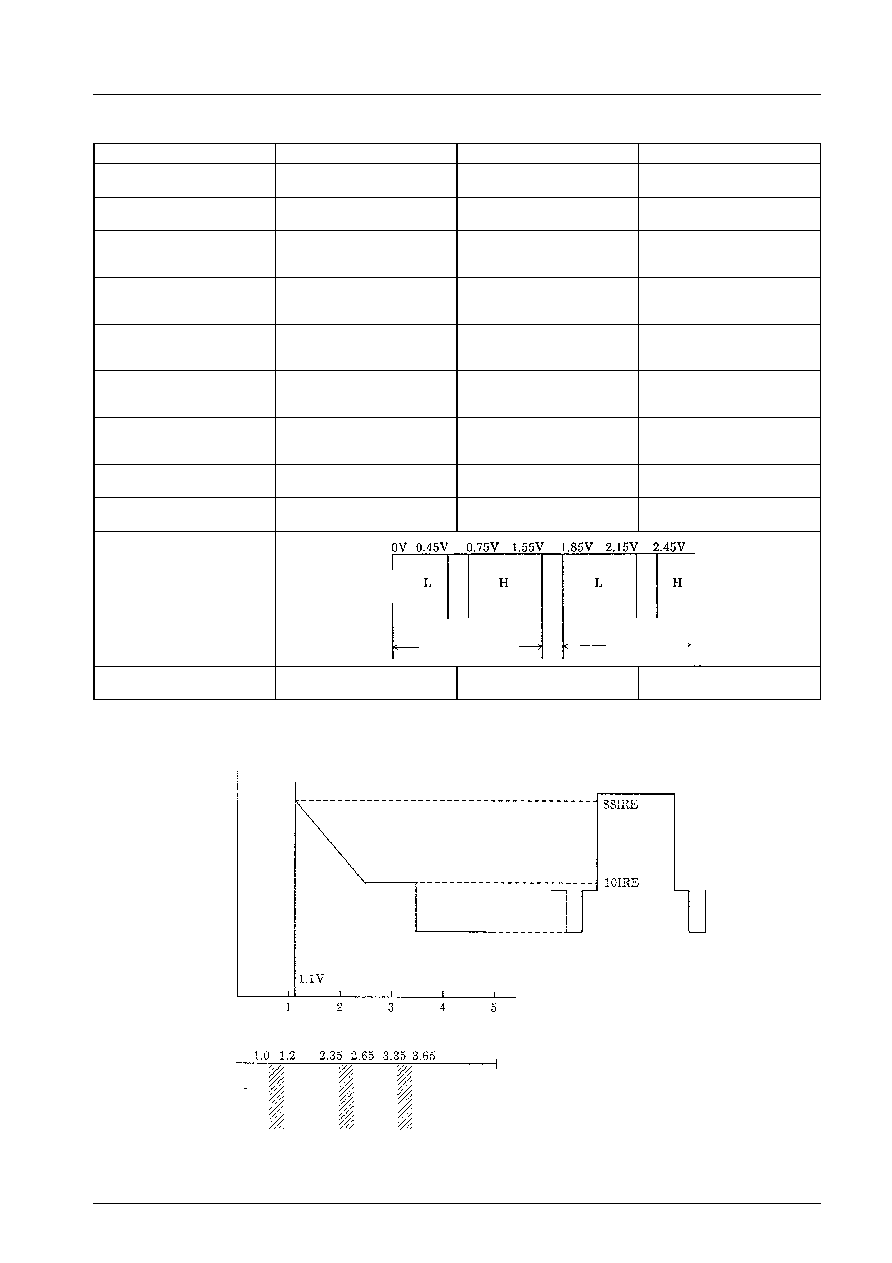
Global VHS-format VCR
Video Signal Processor
Overview
The LA7191N is a multi-format, single-chip video signal
processing IC that supports TV systems around the world.
Features
.
Compatible with TV systems around the world (NTSC/
PAL/MESECAM/4.43 -NTSC/PAL-M/PAL-N).
.
All filters on chip, except for PB-LPF for chroma (cutoff
frequency requires no adjustment).
.
No adjustment of YNR and DOC levels.
.
Double high-pass noise canceller on chip.
.
Linear phase-type picture control on chip.
.
fsc output can be used as clock for OSD IC.
.
DCC circuit on chip.
.
Pilot burst erasure circuit on chip.
.
High-speed AFC circuit on chip.
.
Switching noise canceller on chip.
.
Smallest package in the industry.
.
Few components needed.
.
2fsc output.
.
I/O pin for CNR insertion added.
.
YNR/LNC switching possible.
Package Dimensions
unit: mm
3025B-DIP42S
[LA7191N]
SANYO : DIP42S
Specifications
Maximum Ratings
at Ta = 25�C
Parameter
Symbol
Conditions
Ratings
Unit
Maximum supply voltage
V
CC
max
7.0
V
Allowable power dissipation
Pd max
Ta
%
65�C
1020
mW
Operating temperature
Topr
�10 to +65
�C
Storage temperature
Tstg
�40 to +150
�C
Operating Conditions
at Ta = 25�C
Parameter
Symbol
Conditions
Ratings
Unit
Recommended supply voltage
V
CC
5.0
V
Operating supply voltage range
V
CC
op
4.8 to 5.5
V
Ordering number: EN 5471
Monolithic Linear IC
LA7191N
SANYO Electric Co.,Ltd. Semiconductor Bussiness Headquarters
TOKYO OFFICE Tokyo Bldg., 1-10, 1 Chome, Ueno, Taito-ku, TOKYO, 110 JAPAN
22896HA (II) No.5471 - 1/11

Operating Characteristics
at Ta = 25�C, V
CC
= 5.0 V
Parameter
Symbol
Input Output
Conditions
min
typ
max
Unit
[REC Mode Y]
Current drain REC
I
CCR
When V
CC
= 5 V (when there is no signal),
measure sum of incoming current at pins 35
and 28
95
120
145
mA
AGC adjustment
C
AGC
T37A
V
IN
= 1.0 Vp-p video signal, use VR39 to
adjust T4 output to 0.5 Vp-p
VCA control characteristics
VCA
T37A
T4
Measure T4 output level when S10 is set to 2
0.48
0.5
0.52
Vp-p
AGC adjustment voltage
V
AGC
T37A
T39
Measure T39 DC voltage in above state
3.2
3.4
3.6
V
AGC detection voltage
V
AD
T37A
T38
Measure T38 DC voltage in same manner
1.2
1.4
1.6
V
EE output level
V
EE
T37A T34A Measure T34A output level in same manner
0.95
1.00
1.05
Vp-p
AGC Output 1
AGC 1
T37A
T4
V
IN
= 2.0 Vp-p video signal
Measure T4 output level
500
540
560 mVp-p
AGC Output 2
AGC 2
T37A
T4
V
IN
= 0.5 Vp-p video signal
Measure T4 output level
470
490
500 mVp-p
AGC Output 3
AGC 3
T37A
T4
V
IN
= 700 mVp-p LUMI, 600 mVp-p SYNC
Measure T4 SYNC level
135
150
165 mVp-p
AGC Output 4
AGC 4
T37A
T4
V
IN
= 700 mVp-p LUMI, 150 mVp-p SYNC
Measure T4 SYNC level
70
85
100 mVp-p
Sync separation output level
V
SYR
T37A
T32
V
IN
= 1.0 Vp-p video signal,
Measure T32 output pulse wave high value
4.0
4.2
4.4
Vp-p
Sync separation output
pulse width
PW
SYR
T37A
T32
V
IN
= 1.0 Vp-p video signal,
Measure T32 output pulse width
4.4
4.7
5.0
�s
Sync separation output
leading edge delay time
T
SYR
T37A
T32
V
IN
= 1.0 Vp-p video signal, measure delay
time of output SYNC versus input SYNC
0.6
0.8
1.0
�s
Sync separation threshold
level
TH
SYR
T37A
T32
Gradually attenuate the input level, measure
input level at point when output pulse width
widens 1 �s or more beyond PWSYR
�18
�14
dB
Sync tip level,
pedestal level,
white level measurement
(REC)
L
VOR
T37A
T34
Measure electric potential for each of the T34
video output sync tip, pedestal, and white
peak, and assign the measured values to
L
SYN
, L
PED
, and L
WHI
, respectively
Pseudo V insertion level
(REC)
VDR
T37A
T34
Measure T34 DC voltage when 5 V is applied
to T33, and assign the measured value to
L
VDR
and calculate the difference with L
SYN
VDR = L
SYN
� L
VDR
�80
0
+80
mV
Pseudo H insertion level
(REC)
HDR
T37A
T34
Measure T34 DC voltage when 2.7 V is
applied to T33, and assign the measured
value to L
HDR
and calculate the difference
with L
PED
HDR = L
PED
� L
HDR
�200
�100
0
mV
White insertion level (REC)
WHR
T37A
T34
Measure T34 DC voltage when 1.3 V is
applied to T33, and assign the measured
value to L
WHR
and calculate the difference
with L
WHI
WHR = L
WHI
� L
WHR
150
250
350
mV
VCA detection voltage
V
VCA
T37A
T9
Measure T9 DC voltage
3.1
3.4
3.7
V
REC YNR operation
EP/LP
VR-YNR
T37A
T3
V
IN
= white 50% + CW
(15.8 mVp-p) ratio between 32f
H
component
and 32.5f
H
component
3.5
4.5
5.5
dB
Y-LPF frequency
characteristics
YLPF 1
T37A
T3
V
IN
= standard multiburst signal 1 Vp-p,
2 MHz response to 500 kHz at T3
0.2
0.7
1.2
dB
YLPF2
T37A
T3
V
IN
= standard multiburst signal 1 Vp-p,
4.8 MHz response to 500 kHz at T3
�4.5
�3.5
�2.5
dB
YLPF3
T37A
T3
V
IN
= standard multiburst signal 1 Vp-p,
2 MHz response to 500 kHz at T3, T22A: 5 V
0.4
0.9
1.4
dB
YLPF4
T37A
T3
V
IN
= standard multiburst signal 1 Vp-p,
4.8 MHz response to 500 kHz at T3, T22A:
5 V.
�5.0
�4.0
�3.0
dB
FM modulator output level
V
FM
T40
No input, use VR42 to adjust output
frequency to 4 MHz, measure output level
0.8
1.0
1.2
Vp-p
FM modulator secondary
distortion
H
MOD
T40
Ratio of 8 MHz component to 4 MHz in the
above state
�40
�35
dB
Continued on next page.
LA7191N
No. 5471 - 2/11

Continued from preceding page.
Parameter
Symbol
Input Output
Conditions
min
typ
max
Unit
FM modulator modulation
sensitivity
S
MOD
T4
T40
Measure amplitude of change in output
frequency when 2.6 V DC or 3.1 V DC is
applied to T4, 2 x (f3.1 � f2.6)
1.6
2.0
2.4
MHz/V
FM modulator linearity
L
MOD
T4
T40
Measure output frequency when 2.85 V DC
applied to T4,
L
MOD
=
f2.85 � (f3.1 + f2.6)/2
S
MOD
x 100
�2
0
+2
%
1/2 f
H
carrier shift
CS1
T40
Measure amplitude of change in output
frequency when SW41B is off and SW41A is
switched from on to off
6.8
7.8
9.5
kHz
CS2
T40
Measure amplitude of change in output
frequency when SW41B is on and SW41A is
switched from on to off
6.8
7.8
9.5
kHz
Emphasis gain
G
EMPH
T4A
T5
V
IN
= 0.5 Vp-p 10 kHz sine wave
Measure ratio of levels of input and output
amplitude at T5
�0.5
0
+0.5
dB
Detail enhancer
characteristics
G
ENH1
T4A
T5
V
IN
= 158 mVp-p 2 MHz sine wave
Measure ratio of levels of T5 and T4,
difference with G
EMPH
0.9
1.4
1.9
dB
G
ENH2
T4A
T5
V
IN
= 50 mVp-p 2 MHz sine wave
Measure ratio of levels of T5 and T4,
difference with G
EMPH
2.2
3.2
4.2
dB
G
ENH3
T4A
T5
V
IN
= 15.8 mVp-p 2 MHz sine wave
Measure ratio of levels of T5 and T4,
difference with G
EMPH
4.0
5.0
6.0
dB
G
ENH4
T4A
T5
V
IN
= 15.8 mVp-p 2 MHz sine wave
Measure output amplitude at T5 in edit mode,
difference with G
EMPH
1.8
2.8
3.8
dB
Nonlinear emphasis
characteristics
G
NLEMP1
T4A
T5
V
IN
= 500 mVp-p 2 MHz
Measure ratio of levels of T5 and T4,
difference with G
EMPH
0.5
1.4
2.3
dB
G
NLEMP2
T4A
T5
V
IN
= 158 mVp-p 2 MHz
Measure ratio of levels of T5 and T4,
difference with G
EMPH
2.6
3.8
5.2
dB
G
NLEMP3
T4A
T5
V
IN
= 50 mVp-p 2 MHz
Measure ratio of levels of T5 and T4,
difference with G
EMPH
4.9
6.4
7.9
dB
Main linear emphasis
characteristics
G
ME1
T4A
T5
V
IN
= 50 mVp-p 200 kHz sine wave
Measure ratio of levels of T5 and T4,
difference with G
EMPH
4.9
5.2
5.5
dB
G
ME2
T4A
T5
V
IN
= 50 mVp-p 2 MHz
Measure ratio of levels of T5 and T4,
difference with G
EMPH
13.1
13.6
14.1
dB
White clipping level
L
WC
T4A
T5
V
IN
= 500 mVp-p white 100% video signal
Measure white clipping level at T5
186
193
200
%
Dark clipping level
L
DC
T4A
T5
V
IN
= 500 mVp-p white 100% video signal
Measure dark clipping level at T5
�60
�55
�50
%
Non-linear emphasis
characteristics SP
NLE-SP
T4A
T5
Same as G
NLEMP3
3.0
4.0
5.0
dB
[PB Mode Y]
Current drain PB
I
CC
P
Incoming current at pins 35 and 28 when
V
CC
= 5.0 V
125
155
185
mA
Dropout compensation
period
T
DOC
T39A
T4A
T34A T39A: 4 MHz, 300 mVp-p sine wave
T4A: 0.5Vp-p video signal
T34A: time from when input went to 0 until
T34A output returned, SW10
1
0.35
0.5
0.65
ms
DOC loop gain
GDOC
T39A
T4A
T12
T39A: 4 MHz, 300 mVp-p sine wave
T4A: 0.5Vp-p video signal
T39A: Input/output response when 5H have
elapsed after input went to 0, SW10
3
�1.0
0
+1.0
dB
FM demodulation voltage
V
DEM4
T39A
T3
V
IN
=300 mVp-p, f = 4 MHz, Output DC
voltage
1.5
2.0
2.5
V
FM demodulation sensitivity
S
DEM
T39A
T3
V
IN
= 300 mVp-p, f = 2 MHz, V
DEM2
V
IN
= 300 mVp-p, f = 6 MHz, V
DEM6
Calculate S
DEM
= (V
DEM6
� V
DEM2
)/4
0.36
0.45
0.54 V/MHz
Continued on next page.
LA7191N
No. 5471 - 3/11

Continued from preceding page.
Parameter
Symbol
Input Output
Conditions
min
typ
max
Unit
FM demodulation linearity
L
DEM
L
DEM
=
V
DEM4
� (V
DEM6
+ V
DEM2
)/2
V
DEM6
� V
DEM2
x 100
�3.5
0
+3.5
%
Carrier leak
CL
T39A
T3
V
IN
= 300 mVp-p, f = 4 MHz
Ratio between 4 MHz component of T3 and
S
DEM
�40
�35
dB
PB YNR characteristics
LP/EP
GP-YNR
T4A
T28A V
IN
= white 50% + CW (15.8 mVp-p)
Ratio between 32f
H
component and 32.5f
H
component
�11
�9
�7
dB
PB LNC characteristics
SP
GP-LNC
T4A
T28A V
IN
= white 50% + CW (15.8 mVp-p)
Ratio between 32f
H
component and 32.5f
H
component
�7.0
�5.5
�4.0
dB
Playback through gain
G
PB
T4A
T34A Apply V
IN
= 0.5 Vp-p video signal to pin 4,
and determine ratio between T34A output
level and input level
4.0
5.5
7.0
dB
Nonlinear de-emphasis
characteristics
GNL
DEEM1
T4A
T34A V
IN
= white 50% + CW
(f = 1 MHz, 158 mVp-p)
measure input/output response, difference
with GPB
�2.8
�1.8
�0.8
dB
GNL
DEEM2
T4A
T34A f = 1 MHz, 50 mVp-p
�5.0
�4.0
�3.0
dB
Noise canceller
characteristics
G
WNC1
T4A
T34A f = 1.5 MHz, 158 mVp-p
�1.3
�0.8
�0.3
dB
G
WNC2
T4A
T34A f = 1.5 MHz, 50 mVp-p
�4.5
�3.5
�2.5
dB
G
WNC3
T4A
T34A f = 1.5 MHz, 15.8 mVp-p
�10.5
�9.0
�7.5
dB
PIC-CTL center response
characteristics
G
PC
T4A
T34A f = 2 MHz, 158 mVp-p
1.2
1.7
2.2
dB
PIC-CTL hard response
characteristics
G
PH
T4A
T34A f = 2 MHz, 158 mVp-p
7.0
8.0
10.0
dB
PIC-CTL soft response
characteristics
G
PS
T4A
T34A f = 2 MHz, 158 mVp-p
�10.0
�8.0
�7.0
dB
Nonlinear de-emphasis
characteristics SP
NLDE-SP
T4A
T34A Same as GNL
DEEM2
�5.0
�4.0
�3.0
dB
Sync tip level,
pedestal level,
white level measurement
(PB)
L
VOR
T4A
T34
With V
IN
= white 100% and T34A at 1.0
Vp-p, measure electric potential for each of
the pin 34 video output sync tip, pedestal,
and white peak, and assign the measured
values to L
SYN
, L
PED
, and L
WHI
, respectively
Pseudo V insertion level
(PB)
VDP
T4A
T34
Measure pin 34 DC voltage when 5 V is
applied to pin 33, and assign the measured
value to L
VDP
, and calculate the difference
with L
SYN
VDP = L
SYN
� L
VDP
�80
0
+80
mV
Pseudo H insertion level
(PB)
HDP
T4A
T34
Measure pin 34 DC voltage when 2.7 V is
applied to pin 33, and assign the measured
value to L
HDP
, and calculate the difference
with L
PED
HDP = L
PED
� L
HDP
�300
�200
�100
mV
White insertion level (PB)
WHP
T4A
T34
Measure pin 34 DC voltage when 1.3 V is
applied to pin 33, and assign the measured
value to L
WHP
, and calculate the difference
with L
WHI
WHP = L
WHI
� L
WHP
20
120
220
mV
Sync separation output level
V
SYP
T4A
T32
V
IN
= 0.5 Vp-p video signal, pin 32 output
pulse wave high value
4.0
4.2
4.4
Vp-p
Sync separation output
pulse width
PW
SYP
T4A
T32
V
IN
= 0.5 Vp-p video signal, T32 output pulse
width
4.4
4.7
5.0
�s
Sync separation output
leading edge delay time
T
SYP
T4A
T32
V
IN
= 0.5 Vp-p video signal, measure delay
time of output SYNC versus input SYNC
0.9
1.1
1.3
�s
4.2 V regulator operation
check
V
REG
T30
Measure DC level of T30 in REC mode
3.95
4.15
4.35
VDC
[REC Mode Chroma]
REC chroma low-band
conversion output level
V
OR-15
T37A T15A V
IN
= standard color bar signal (1 Vp-p),
measure burst level at T15A
120
160
200
mVp-p
Burst emphasis amount
(NTSC mode)
GBE
T37A T15A V
IN
= standard color bar signal (1 Vp-p)
Ratio of burst level at T15A when S41A is off
(SP/EP) and on (LP)
5.5
6.0
6.5
dB
Continued on next page.
LA7191N
No. 5471 - 4/11

Continued from preceding page.
Parameter
Symbol
Input Output
Conditions
min
typ
max
Unit
VXO oscillation level
V
VXO-R
T37A
T19
V
IN
= standard color bar signal (1 Vp-p),
measure T19 output amplitude (with a FET
probe)
450
560
670
mVp-p
REC ACC characteristics
ACC
R1
T37A T15A V
IN
= standard color bar signal (1 Vp-p),
input +6 dB chroma signal level only,
measure T15A burst level, and calculate ratio
with V
OR
-15
0.2
0.5
dB
ACC
R2
T37A T15A V
IN
= standard color bar signal (1 Vp-p),
input �6 dB chroma signal level only,
measure T15A burst level, and calculate ratio
with V
OR
-15
�0.5
�0.1
dB
REC ACC killer input level
VACC
K-ON
T37A T15A V
IN
= standard color bar signal (1 Vp-p),
lower the chroma signal, and measure the
input burst level at the point where output at
T15A ceases, and calculate the ratio with the
standard input level
�26
dB
REC ACC killer output level
VO
ACCK
T37A T15A Use a spectrum analyzer to measure the
output level at T15A in the killer state
described previously; ratio with V
OR-15
�60
�50
dB
Input level for REC ACC
killer return
V
ACCK-OFF
T4A
T34A Starting from the killer state described
previously, gradually raise the input chroma
level and measure the input burst level when
output is generated at T15A and calculate the
ratio with the standard input level
�20
dB
VXO control sensitivity
S
VXO
T37A T17
T19A
Measure the pin 17 DC voltage when a
standard color bar signal is input
(1 Vp-p)...V
0
Measure the frequency at T19A when V
0
is
applied to pin 17 from the external power
supply...f
1
Measure the frequency at T19A when V
0
+
10 mV is applied to pin 17...f
2
S
VXO
=
f
2
� f
1
10
Hz/mV
3.8
5.7
7.6
Hz/mV
REC APC pull-in range
f
APC1
T37A T15A Input a 50% white signal overlapped with a
4.4336 MHz, 300 mVp-p continuous wave.
After confirming that there is output at T15A,
increase the frequency of the CW until the
output at T15A stops, and then gradually
reduce the frequency until output appears
again at T15A; that CW frequency is f1.
f
APC1
= f1 � 4433619 (Hz)
350
440
Hz
f
APC2
T37A T15A In the same manner, reduce the frequency of
the CW until the output at T15A stops, and
then gradually increase the frequency until
output appears again at T15A; that CW
frequency is f2.
f
APC2
= f2 � 4433619 (Hz)
�900
�350
Hz
BGP delay time
t
D
T37A
T32
T36
Measure waveforms at T32 and T36 when a
standard color bar signal (1 Vp-p) is input.
4.3
�s
BGP pulse width
t
W
T37A
T32
T36
4.8
�s
Continued on next page.
LA7191N
No. 5471 - 5/11

Continued from preceding page.
Parameter
Symbol
Input Output
Conditions
min
typ
max
Unit
REC AFC pull-in range
f
AFC1
T37A
T24
Input a string of pulses (negative polarity) at
300 mV, 15.6 kHz with a width of 5 �s. After
increasing the frequency of the pulse string
until the waveform at pin 24 is disrupted,
then reduce the frequency until the waveform
at pin 24 is normal again; that pulse string
frequency is f
1
.
f
AFC1
= f
1
� 15.625 (kHz)
1.0
7.0
kHz
f
AFC2
T37A
T24
In the same manner, after reducing the
frequency of the pulse string until the
waveform at pin 24 is disrupted, then
increase the frequency until the waveform at
pin 24 is normal again; that pulse string
frequency is f
2
.
f
AFC2
= f
2
� 15.625 (kHz)
�3.7
�1.0
kHz
[PB Mode Chroma]
PB chroma video output
level
Vop-34
T39A
T15A
T4A
T34A In PB, SP mode, input a 4 MHz: 300 mVp-p
continuous wave at T39A, and from T15A
input a chroma signal (SP mode, burst 50
mVp-p) that underwent low-band conversion
from a chroma noise test signal.
Input a 50% white signal from T4A and
measure the T34A burst level
240
300
360 mVp-p
PB chroma pin 31 output
level
Vop-31
T39A
T15A
T4A
T31
Measure the T31 burst level under the same
conditions as for Vop-34.
220
270
320 mVp-p
PB ACC characteristics
ACC
P1
T39A
T15A
T4A
T31
Input the input chroma level at +6 dB under
the same conditions as for Vop-34 and
measure the T31 burst level, and calculate
the ratio with Vop-31.
0.5
0.8
dB
ACC
P2
T39A
T15A
T4A
T31
Input the input chroma level at �6 dB under
the same conditions as for Vop-34 and
measure the T31 burst level, and calculate
the ratio with Vop-31.
�0.5
�0.2
dB
PB killer input level
V
ACK-P
T39A
T15A
T4A
T31
Lower the input chroma level under the same
conditions as for Vop-34 and measure the
input burst level at the point where T31
chroma output ceases. (Calculate ratio with
standard input of 50 mVp-p)
�40
�32
�25
dB
PB killer chroma output
level
V
OACK-P
T39A
T15A
T4A
T34A Use a spectrum analyzer to measure the T34
chroma output level in the killer state
described previously. Calculate ratio with
Vop-34.
�44
�40
dB
PB main converter carrier
leak
C
LP
T39A
T14A
T4A
T34A Monitor T34A with a spectrum analyzer under
the same conditions as for Vop-34 and
calculate the ratio between the 4.43 MHz
component and the 5.06 MHz carrier leak
component.
�40
�33
dB
Burst de-emphasis amount
(NTSC mode)
GBD
T39A
T4A
T27A
T31
From T39A, input a 4 MHz 300 mVp-p
continuous wave; from T4A, input a 50%
white signal, and calculate the ratio between
the output level during the T31 burst interval
and the output level during other intervals.
�4.40 �4.65 �4.90
dB
PB XO output level
V
XO-P
T19
Measure the PB mode T19 output level with
an FET probe
480
610
750
mVp-p
PB XO oscillation frequency
variation
f
XO
T19A Measure the frequency at T19A during PB
mode...f
f
XO
= f � 4433619 (Hz)
�9
0
+9
Hz
Continued on next page.
LA7191N
No. 5471 - 6/11

Continued from preceding page.
Parameter
Symbol
Input Output
Conditions
min
typ
max
Unit
SLD detection current
I
SLD1
T39A
T4A
T23A In PB mode, with S24: 3 and S23: off, input a
4 MHz 300 mVp-p continuous wave from
T39A, input a 50% white signal from T4A,
and measure the wave peak at T23A
I
SLD1
= VOS1/1 k
135
�A
I
SLD2
T39A
T4A
T23A Same as above (however, S24 = 1)
I
SLD2
= VOS2/1 k
135
�A
2fsc output level
V2fsc
T21
In PB mode, measure the T21 output level
with an FET probe
480
640
800
mVp-p
Note) A trap (4.84 MHz for NTSC systems and 5.69 MHz for PAL systems) is required in the chroma playback system (between
pins 25 and 27 or between pins 31 and 29) in order to suppress unnecessary components in converter output.
LA7191N
No. 5471 - 7/11

Equivalent Circuit Block Diagram and Sample Application Circuit
Unit (resistance:
, capacitance: F)
LA7191N
No. 5471 - 8/11

LA7191N Control Pins
Pin No.
Function
Control
Contents
20
N.C control
Linear
When
high, N.C
Strong
22
Filter switching
H
3.58 MHz system
L or OPEN
4.43 MHz system
42
YNR/LNC selection
OPEN
YNR
L
LNC (line noise canceller)
Test Circuit Diagram
Unit (resistance:
, capacitance: F)
LA7191N
LA7191N
No. 5471 - 9/11

Control Pin Function Chart
Pin No.
L
M
H
Pin 5
R/P switching
Open
REC mode
Over 3.8V
PB mode
Pin 1
SP changeover
Open
Over 3.9 V
SP mode
Pin13
EDIT2
PIC-CTL
2 V to 2.5 V
PIC-CTL
SOFT
2.5 V to 3 V
PIC-CTL
HARD
Over 3.6 V
EDIT ON
Pin 14
SECAM
CTL
Over 4.0 V
SECAM mode
Pin 17
Special playback switching
Open
Before comb in SP
Over 3.5 V
(over 200 �A)
After comb in SP
Pin 27
MESECAM
CTL
Open
Over 3.0 V
MESECAM mode
Pin 33
QV, QH, CHAR
Refer to Pin 33,
QV, QH, CHAR,
insertion diagram
Pin 36
NTSC-CTL
NTSC mode if current is
150 �A or more
Pin 40
DOC STOP control
Open
Normal mode
Over 3.9 V
DOC STOP
Pin 41
ROTARY pulse
LP switch
ROTARY
PULSE
Tape
speed
SP or EP mode
LP mode
Pin 42
YNR/LNC switch
Line NC when
under 1 V in PB
Open
SP: LNC, LP/EP: YNR
Pin 33
QV, QH, CHAR, insertion
Pin
34
output
voltage
Pin 33 control voltage
(V)
THROUGH
CHAR
QH
QV
Through
LA7191N
No. 5471 - 10/11

No products described or contained herein are intended for use in surgical implants, life-support systems, aerospace equipment,
nuclear power control systems, vehicles, disaster/crime-prevention equipment and the like, the failure of which may directly or
indirectly cause injury, death or property loss.
Anyone purchasing any products described or contained herein for an above-mentioned use shall:
1
Accept full responsibility and indemnify and defend SANYO ELECTRIC CO., LTD., its affiliates, subsidiaries and distributors
and all their officers and employees, jointly and severally, against any and all claims and litigation and all damages, cost and
expenses associated with such use:
2
Not impose any responsibility for any fault or negligence which may be cited in any such claim or litigation on SANYO
ELECTRIC CO., LTD., its affiliates, subsidiaries and distributors or any of their officers and employees jointly or severally.
Information (including circuit diagrams and circuit parameters) herein is for example only; it is not guaranteed for volume
production. SANYO believes information herein is accurate and reliable, but no guarantees are made or implied regarding its use
or any infringements of intellectual property rights or other rights of third parties.
This catalog provides information as of February, 1996. Specifications and information herein are subject to change without notice.
LA7191N
No. 5471 - 11/11










